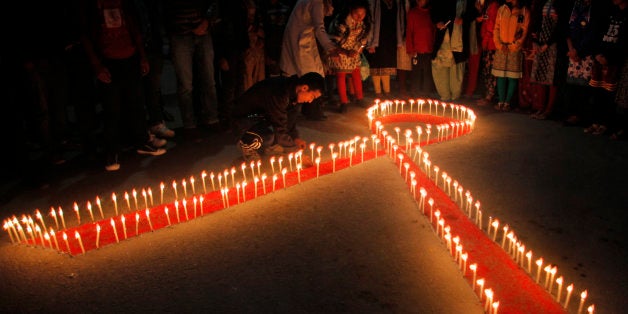
Breakthroughs in scientific medical research have prompted AIDS activists and politicians to envision "an AIDS-free generation." UNAIDS has begun a countdown to zero: "No new HIV infections, no discrimination, and no new AIDS deaths."
This slogan of "Getting to zero" has been the reoccurring theme of World AIDS Day for the past four years. The great news is that AIDS-related deaths can virtually be eliminated with new medications. Stopping new infections has become a realistic goal too, if persons infected with HIV get tested and treated with appropriate anti-retroviral drugs. Their viral load can become undetectable, and they have virtually no chance of infecting others.
The bad news is that achieving the goal of "no discrimination" of those infected with the disease remains elusive and threatens to undermine the progress on these other two worthy objectives. More than 30 years into the global pandemic, a combination of misinformation about how the disease is transmitted along with deep negative cultural and religious norms regarding appropriate sexual behavior undermine public health policies and programs. Sadly, people neither get tested on a regular basis nor receive anti-retroviral treatment, even when it is readily available. The rate of new infections within the US remains stubbornly at over 50,000 per year. An overwhelming reason is that the social stigma associated with HIV and AIDS is far more prevalent and profound than usually recognized.
In a recent article published by the University of Chicago Press in Economic Development and Cultural Change, Vivian Hoffman, Jacob R. Fooks, and myself show that both the unwarranted fear of contagion and the perceived association with socially undesirable behavior keep people from coming into contact with basic everyday items that were made by people who were HIV positive. Specifically, the study involved people living in 10 Kenyan villages who refused food or other common household items that had been touched by people living with HIV.
Despite medical advances, getting to zero as envisioned by UNAIDS is impossible unless systematic efforts are undertaken to both measure and mitigate HIV stigma. Too many people fear being identified as HIV positive because of social stigma. They avoid getting tested and treated.
My team measured the depth of people's stigma using real money in economic experiments, not just relying on anecdotes or hypothetical surveys. Residents in rural Kenya were offered cash (up to $8,641 per person) to eat a bag of peanuts, but 50 percent refused this amount simply because the food had been packaged by someone who was HIV positive. Likewise, nearly half of participants refused this amount in exchange for washing with detergent that had been touched by some who has HIV, and 40 percent declined rather than use a broom that had been touched by an infected person. This is remarkable behavior given that the average earnings in rural Kenya are approximately $2.25 a day, just over $800 a year.
The intensity of the stigma and fear is remarkably powerful and inhibiting, valued higher than 10 years income for some in Kenya. Even though no one has ever been infected by eating foods, washing with detergents or using a broom produced by an HIV positive person, nearly half of the 300 people involved responded as if they were deciding between life and death.
Related studies conducted in the United States found strikingly similar results. In unpublished research, these researchers found that when asked to eat a brownie produced by a person who is HIV positive and a brownie produced by a person who is HIV negative, college students had to be paid an average of $42,634 more to eat the first brownie.
Fortunately, there was some good news in these studies. Providing accurate medical information about HIV transmission reduced the refusal rate in Kenya by nearly 20 percent. Likewise, messages that remind people how HIV is transmitted also reduced the refusal rate by nearly 20 percent. Direct education can help reduce HIV-related stigma and make previously unacceptable products acceptable again.
Campaigns to reduce HIV stigma should address both the fear of transmission and the social dimension of stigma. Those working on HIV/AIDS issues must not only invest in medication, but also in educational efforts targeting mitigation by addressing misinformation about how people are infected and challenging cultural and/or religious influences that may consciously or unconsciously fuel stigmatization and discrimination.
Ultimately, measuring and mitigating stigma must become a higher priority for both governments and non-government organizations in Africa, the United States and throughout the world. By doing this the vision of "ending AIDS in our generation" can become a reality, not just a slogan.